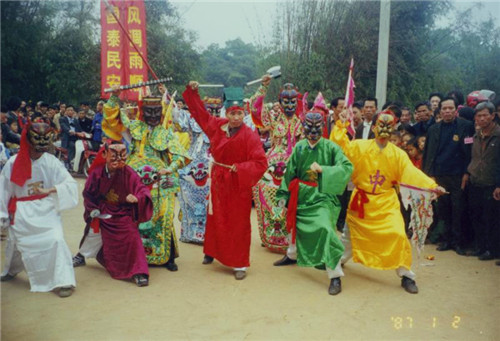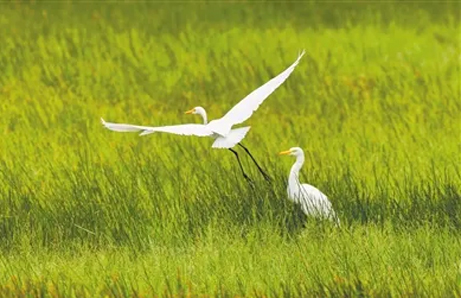Home> Photos
Zhanjiang Nuo dance
Rising out of a primordial religion dating from antiquity, Nuo dance is considered somewhat of a living fossil in China. Meaning oath, binding utterance, or exorcism, Nuo is held in special significance in Chinese religious culture.
Oaths and exorcisms were integral aspects of life for many Han during the Shang and Zhou dynasties (16th century-3th century BC), throughout China, as well as for several ethnic groups in the southeast. With much of the mysteries of nature yet unrevealed at that time, people contrived to worshipping gods and exorcising demons in order to understand the world around them – and so the sacrificial Nuo dance was born.
Nuo dance embodied a metaphorical talisman to avert evil and protect people from the unexplained events that befell them, such as natural disasters and disease epidemics, which at times would wipe out large swathes of the population and decimate livestock.
Those taking part in the Nuo dance would wear expressive hand carved wooden masks, representing capricious gods and valiant heroes, the often ferocious faces were thought to scare off ghosts and demons. Drums and gongs would be pounded in rhythm to represent thunder and the power of nature, while dancers performed the sacrificial rites.
The General Record of Guangdong, published during the Ming Dynasty (1368-1644), recorded that people in Zhanjiang dressed as ghosts and danced to the beat of drums and gongs during Lantern Festival – the earliest record of the practice in the area.
At that time, many people in the area worshipped the god of thunder, a deity who embodied the ferociousness of nature, and force which would regularly affect people and property. The Lei, from Leizhou Peninsula translates to "thunder" in English.
All over China, and even across Zhanjiang, the Nuo dance means different things to different people depending on the specific circumstances and traditions in that area.
 |
"Zouqingjiang" popular in Nanxing town, comprises six dancers wearing Nuo masks and one human to reflect people's wishes to ward off evil and disaster. [Photo/yinsha.com] |
In Nanxing, Songzhu and Leigao towns, Nuo dance is called "Zouqingjiang", and involves the burning of effigies which represent the demons they want exorcized. Handmade paper boats are also set adrift on rivers to ward off evil spirits and prevent disasters. In Huguang and Taiping towns, Nuo dance is referred to as "Kaobing" and sees volunteers roll across thick branches of thorns to show their bravery in the face of evil.
In Da'an village "Wuerzhen" nominates two dancers to play ancient heroes General Che and General Mai to fight of evil spirits with swords and axes. "Wuliujiang", as it is called in Bopu town, brings to life six figures from Chinese myth and legend. The dancers wear lifelike wooden masks with different expressions, and shout, jump and stamp on the ground in a martial arts performance.
There are two types of Nuo masks used in Zhanjiang. Ferocious and scary masks which represent the god of thunder and his followers, and dignified and amiable masks, representing ancient heroes such as Guan Yu, who embody loyalty, honor and strength.
Nuo dances are still performed in Zhanjiang and all over China to this day, but represent a rose-tinted much-loved tradition, rather than a protector against evil. In most areas, Nuo has been transformed into a folk dance for entertainment, replacing solemnity and mystery with artistic expression.
Nuo dance was selected among the second batch of national intangible cultural heritages in 2008.

 Print
Print Mail
Mail 5G construction supports Zhanjiang's high-quality development
5G construction supports Zhanjiang's high-quality development
 Acting mayor inspects project construction in Xuwen, Leizhou
Acting mayor inspects project construction in Xuwen, Leizhou Zhanjiang island an "egret paradise"
Zhanjiang island an "egret paradise"  Dancing egrets add vitality to Xiashan
Dancing egrets add vitality to Xiashan